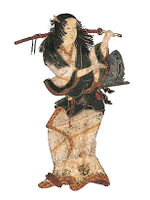Izumo no Okuni

Okuni (出雲の阿国 Izumo no Okuni) (1572?-?) was the originator of kabuki theater. She was believed to be a miko at the Grand Shrine of Izumo[1] who began performing this new style of dancing, singing, and acting in the dry riverbeds of Kyoto.
Contents |
History
Early years
Okuni grew up in the vicinity of the Izumo shrine, where her father worked as a blacksmith, and where several other family members served. Eventually Okuni joined as a miko[2], where she was known for her skill in dancing and acting, as well as her beauty. As it was a custom of the time to send priests, miko and others to solicit contributions for the shrine, she was sent to Kyoto to perform sacred dances and songs.
It was during her performances in Kyoto that she also became known for her performances of nembutsu odori (or nembutsu dance) in honor of the Amida Buddha. Though this dance traces its origins to Kūya, a tenth-century evangelist of Pure Land Buddhism, by Okuni's time it had become a largely secular folk dance, and her particular adaptation tended to be known for its sultriness and sexual innuendo.[1] Other popular themes for Okuni's acts included humorous skits about lover's trysts at various public establishments and meetings between men and prostitutes. Between these and other dances and acts, she garnered much attention and began to draw large crowds wherever she performed. Eventually she was summoned to return to the shrine, a call she ignored, though she continued to send money back.
Founding of kabuki

Around 1603, Okuni began performing on the dry riverbed of the Shijōgawara (Fourth Street Dry Riverbed) of the Kamo River and at Kitano Shrine.[3] Gathering up the female outcasts and misfits of the region, particularly those involved in prostitution[1], Okuni gave them direction, teaching them acting, dancing and singing skills in order to form her troupe. Several theories exist as to the etymology of the word kabuki, one being that it is derived from those who, oddly dressed and swaggering on the street, had been dubbed kabukimono (from kabuku "to lean in a certain direction", and mono, "people"). Another possible origin is katamuki, which means "slanted" or "strongly-inclined."[1] In either case, others labeled Okuni's troupe's performances kabuki due to their eccentricity and social daring. The earliest performances of kabuki were dancing and song with no significant plot, often disdained as gaudy and cacophonous, but equally lauded as colorful and beautiful.
As mentioned above, Okuni's troupe was exclusively female. Thus, she required her actors to play both male and female roles. In particular, Okuni herself was best known for her roles as samurai and Christian priests. As her troupe gained fame, she was emulated by many others, particularly brothels, which offered such shows to amuse wealthy clients, as well as to gain prostitutes who had marketable acting and singing skills. This new style of exclusively female troupes became known by the alternate names of shibai[2], onnakabuki, (from onna, the Japanese word for "woman" or "girl") and Okuni kabuki.[3]
Later years

Eventually, with the aid of Ujisato Sanzaburō, who supported Okuni financially as well as artistically, kabuki evolved into a more dramatic style. On a more personal level, Sanzaburō was also said to be Okuni's lover, though they did not marry. After his death she continued without him, continuing to merge the drama with the music and dance. Eventually, her fame and that of her kabuki troupe spread throughout Japan.
Okuni retired around 1610, and after that time she disappeared. In 1629, due to public outcry of morals, those under the shogun Tokugawa Ieyasu forbade women from performing in kabuki. This was quickly replaced by the use of young men as actors/"actresses," though this was quickly banned as well due to some of the same issues of prostitution and corruption of morals, restricting the performances to those by older men, which is a standing practice in the official theatres even today.[1]
There are several theories of Okuni's year of death: some say in 1613, others in 1640[2] or 1658.
In November 2002 a statue was erected in her honor and to commemorate 400 years of kabuki.[4] It is located on Kawabata Street at the north of the Shijō Ōhashi, near the shore of the Kamo River in Kyoto.
Cultural impact
In addition to her founding of kabuki, Okuni contributed to Japanese theatre in general. She is said to have introduced the forerunner of the hanamichi (path of flowers), a runway leading from the rear of the theatre and crossing between the audience to the stage. This has been incorporated in several Japanese theatre arts beyond that of kabuki.
See also
Notes and references
- ↑ 1.0 1.1 1.2 1.3 1.4 Paul Varley, Japanese Culture, 4th Ed.. Honolulu: University of Hawai'i Press. pp. pp. 186-187. ISBN 9780824821524.
- ↑ 2.0 2.1 2.2 "Okuni." Japan Encyclopedia. Ed. Louis Frédéric. Trans. Käthe Roth. Harvard University Press.
- ↑ 3.0 3.1 "Okuni." Japan: An Illustrated Encyclopedia. Vol 2. Kodansha. ISBN 4-06-206490-1.
- ↑ Sign (in English) for Izumo no Okuni's statue in Kyoto
External links
- "Viva Kabuki!: Izumono no Okuni", Insite-Tokyo, February 1999
- "Izumo no Okuni", at Distinguished Women
- Izumo no Okuni, Japanese Art and Architecture Net Users System
- "Izumo no Okuni", at Drama Archives
|
||||||||||||||